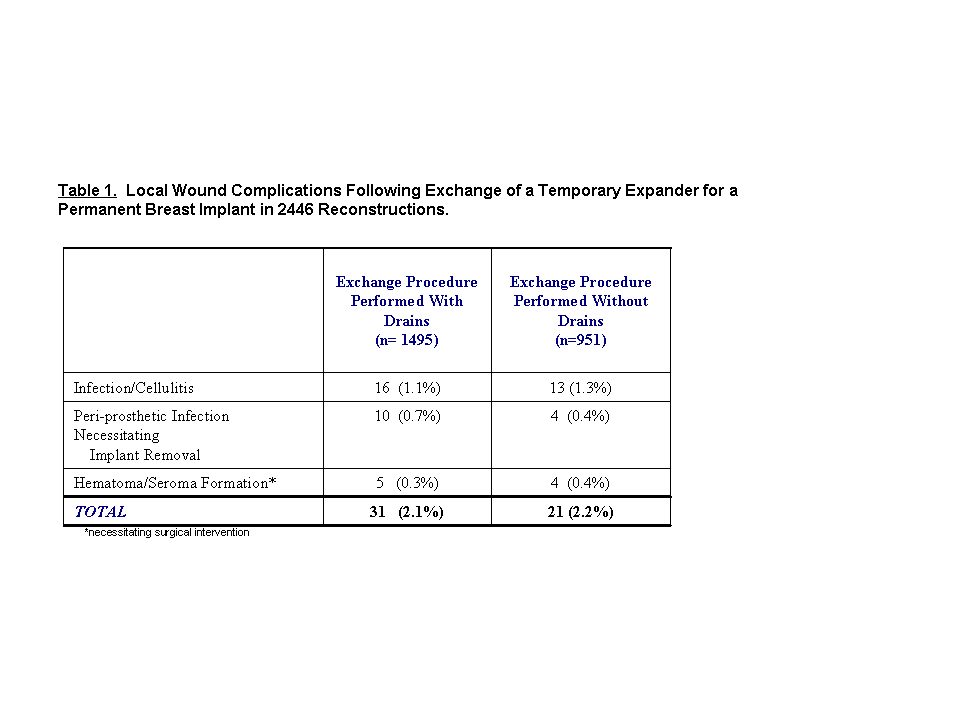McCormick Place, Lakeside Center
Sunday, September 25, 2005
9:00 AM - 5:00 PM
McCormick Place, Lakeside Center
Monday, September 26, 2005
9:00 AM - 5:00 PM
McCormick Place, Lakeside Center
Tuesday, September 27, 2005
9:00 AM - 5:00 PM
McCormick Place, Lakeside Center
Wednesday, September 28, 2005
9:00 AM - 5:00 PM
8364
The Effect of Closed-Suction Drains On The Incidence Of Local Wound Complications Following 2446 Tissue Expander/Implant Reconstructions: A Cohort Study
PURPOSE: Seroma formation can be associated with infection necessitating implant removal after breast reconstruction. Although closed suction drains are advocated by some authors as a means of preventing these complications, empirical evidence for their use is lacking. In addition, the possibility of peri-prosthetic, infectious complications arising from communication with closed-suction drains has been proposed. The purpose of this investigation was to evaluate the effect of peri-prosthetic, closed-suction drains on local wound complications including infection, seroma and hematoma formation in patients undergoing exchange of a temporary expander for a permanent breast implant.
PATIENTS & METHODS: A review of all tissue expander/implant breast reconstructions performed at a tertiary care cancer center between January 1997 and December 2004 was performed. Patient demographic, reconstructive and complication data was obtained from a prospectively-maintained reconstructive database. Two patient cohorts were identified: i) patients who underwent exchange of their tissue expander to a permanent implant with the use of closed-suction drains; and, ii) patients who underwent the exchange procedure without the use of drains. The incidence of complications including infection, seroma and hematoma formation was determined for each cohort. Seroma and/or hematoma formation was defined here as a clinically significant fluid collection necessitating surgical and/or percutaneous drainage. Chi-square and two-sample t-tests were performed for categorical and continuous variables, respectively.
In the patient cohort who received drains, closed-suction drains were routinely placed in the implant pocket at the time of the exchange procedure. Drains were removed when drain-output per day °Ü 30 cc / 24 hours. Broad-spectrum intravenous antibiotics were administered to all patients peri-operatively.
RESULTS: A total of 2446 exchange procedures in 1863 patients were performed over the study period. In 1495 reconstructions (1165 patients), drain(s) were placed intra-operatively following exchange of the expander for a permanent implant. In 951 reconstructions (698 patients), no drains were used.
There was no difference in the rate of complications following the exchange procedure performed with or without the use of drains (p=0.180). The overall rate of complications was 2.4%. The most common complication in both groups was infection. There was no difference in the incidence of peri-prosthetic infection necessitating implant removal in the presence of drains compared to that in the absence of drains (p=0.428). Similarly, there was no significant difference in the rate of hematoma or seroma formation with and without the use of drains (p=0.950 and p=0.648, respectively).
CONCLUSION: The use of peri-prosthetic, closed-suction drains following exchange of a temporary expander for a permanent breast implant does not affect the incidence of peri-operative complications including infection, seroma or hematoma formation.

View Synopsis (.doc format, 61.0 kb)
